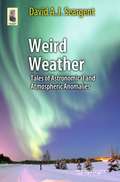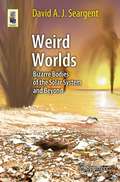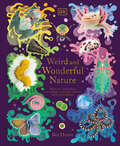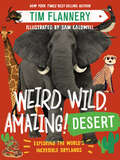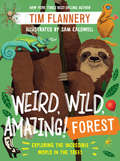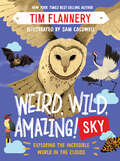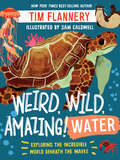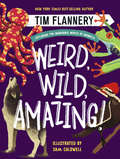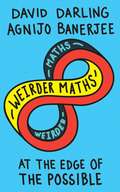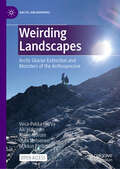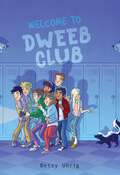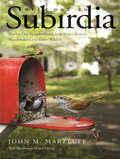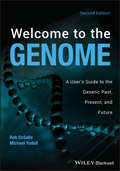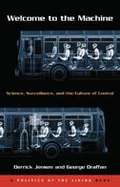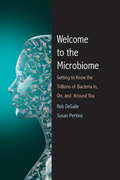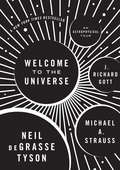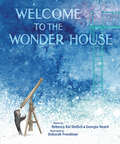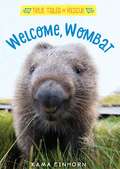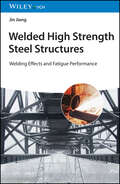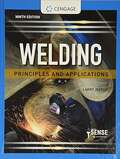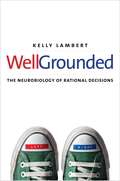- Table View
- List View
Weird Weather
by David A. SeargentThis book is, in a sense, a sequel to David Seargent's first Springer book Weird Astronomy (2010). Whereas Weird Astronomy extended over a broad range of purely astronomical topics, the present work concentrates on phenomena closer to home; the atmospheric and "shallow space" events as opposed to deep space events. The line between astronomy and meteorology is blurred - a fact that is discussed in Weird Weather. It is not primarily a book of "wonders" or of the unexplained, although some of the topics covered remain mysteries. It is primarily directed toward those who are fascinated by climate and weather, and who are open-minded when considering Earth's climate, what drives it, and what are the causes of climate change. The author, David A. J. Seargent, presents the facts with a balanced and scientific approach. Weird Weather: Tales of Astronomical and Atmospheric Anomalies is about strange, unusual, and apparently inexplicable observations of the air and sky. Primarily these are in the Earth's atmosphere, but there are corresponding phenomena in the atmospheres of other planets of the Solar System - lightning on Venus, Jupiter, and Saturn, whirlwinds and dust storms of Mars, and auroras on Jupiter. Topics include anomalous lights, anomalous sounds, spectacular effects of cloud illumination by the Sun or Moon, lightning phenomena, electrophonic sounds of lightning, aurora and meteors, tornado and whirlwind phenomena on Earth and Mars, usual atmospheric effects, mirages, and the possible astronomical influences on cloud and climate.
Weird Worlds
by David A. Seargent"Weird Worlds" is the third book in David Seargent's "Weird" series. This book assumes a basic level of astronomical understanding and concentrates on the "odd and interesting" aspects of planetary bodies, including asteroids and moons. From our viewpoint here on Earth, this work features the most unusual features of these worlds and the ways in which they appear "weird" to us. Within our own Solar System, odd facts such as the apparent reversal of the Sun in the skies of Mercury, CO2-driven fountains of dust on Mars, possible liquid water (and perhaps primitive life!) deep within the dwarf planet Ceres, and a variety of odd facts about the planetary moons are all discussed. A special chapter is devoted to Saturn's giant moon Titan, and its methane-based weather system and "hydrological" cycle. This chapter also includes recent speculation on the possibility of methane-based organisms and the form that these might take, if they really do exist. Beyond our Solar System, the book looks at the range of worlds discovered and hypothesized. In "Weird Worlds," the author discusses planets where temperatures are so high that it rains molten iron, and others so cold that liquid methane floods across plains of ice! Worlds are described where the lightest element acts like a metal and where winds blow at thousands of miles per hour - as well as possible planets whose orbits are essentially parabolic. In keeping with previous titles in David Seargent's "Weird" series, "Weird Worlds" contains several projects that astronomers of all levels can undertake.
Weird and Wonderful Nature: Tales of More Than 100 Unique Animals, Plants, and Phenomena (DK Treasures)
by Ben HoareEnjoy more than 100 extraordinary stories of unusual species, behaviors, and objects all told by author Ben Hoare.Why do Mexican jumping beans jump? How do sea cucumbers defend themselves? What causes the northern lights? This book is filled with facts about the most surprising and curious plants, animals, rocks, and phenomena in nature.Children aged 7-9 can read stories of more than one hundred unique animals, plants and phenomena and learn about the weird and wonderful side of the natural world. Weird and Wonderful Nature is the third installment of the DK Treasure&’s series, exploring the many bizarre animals and plants that are uniquely adapted to their way of life.This fascinating nature book for kids offers: - Facts from a range of topics, from animals to plants and rocks to natural phenomena, that are guaranteed to wow adults and children alike.- Large photographs that show each species or item in incredible detail, with diagrams help to support understanding.- A gold foil cover and beautiful illustrations, making this book an ideal gift for young nature lovers.In Weird and Wonderful Nature, Ben Hoare&’s friendly, informative explanations are paired with photographs and charming illustrations to make sure every page captivates the imagination, while a glossary and index help to navigate the chapters.The third title by best selling author Ben Hoare, after Nature&’s Treasures and The Secret World of Plants, this is the ideal gift book series that will be treasured for years to come.More in the SeriesWeird and Wonderful Nature is part of DK&’s Treasure&’s series. Complete the series and inspire your child's curiosity in natural world with Nature&’s Treasures, or bring out their inner botanist with The Secret World of Plants.
Weird, Wild, Amazing! Desert: Exploring the World's Incredible Drylands
by Tim FlanneryInternationally renowned author and scientist Tim Flannery explores Earth’s deserts and grasslands and the extraordinary animals that live in them. Are zombie ants real? How high can an armadillo jump? What’s it like to wrestle a python? Tim Flannery has the answers. In this informed and accessible book, he introduces some of the most spectacular and unusual creatures in our planet’s deserts and grasslands with in-depth and often-bizarre facts. Flannery ties together concepts of climate change, evolution, conservation, and taxonomy throughout each animal’s profile, firmly connecting it to its environment while sparking wonder at its role in the natural world. Packed with vibrant illustrations and guided by real-life anecdotes from one of our greatest science communicators, Weird, Wild, Amazing! Desert teaches readers to cherish and delight in our planet’s ecosystems with Flannery’s signature mix of humor and wisdom.
Weird, Wild, Amazing! Forest: Forest
by Tim FlanneryInternationally renowned author and scientist Tim Flannery explores our planet’s forests and the extraordinary animals that live in them. Can spiders fly? Are dire wolves real? Do chameleons practice magic? Tim Flannery has the answers. In this informed and accessible book, he introduces some of the most spectacular and unusual creatures in Earth’s forests with in-depth and often bizarre facts. Flannery ties together concepts of climate change, evolution, conservation, and taxonomy throughout each animal’s profile, firmly connecting the animal to its environment while sparking wonder at its role in the natural world. Packed with vibrant illustrations and guided by real-life anecdotes from one of our greatest science communicators, Weird, Wild, Amazing! Forest teaches readers to cherish and delight in our planet’s ecosystems with Tim Flannery’s signature mix of humor and wisdom.
Weird, Wild, Amazing! Sky: Exploring the Incredible World in the Clouds
by Tim FlanneryInternationally renowned author and scientist Tim Flannery takes readers to the skies to learn about the extraordinary animals that fly in them. Can owls swim? Do woodpeckers eat wood? Are vampire bats real? Tim Flannery has the answers. In this informed and accessible book, he introduces some of the most spectacular and unusual creatures soaring through Earth’s skies with in-depth and often-bizarre facts. Flannery ties together concepts of climate change, evolution, conservation, and taxonomy throughout each animal’s profile, firmly connecting it to its environment while sparking wonder at its role in the natural world. Packed with vibrant illustrations and guided by real-life anecdotes from one of our greatest science communicators, Weird, Wild, Amazing! Sky teaches readers to cherish and delight in our planet’s ecosystems with Flannery’s signature mix of humor and wisdom.
Weird, Wild, Amazing! Water: Water
by Tim FlanneryInternationally renowned author and scientist Tim Flannery explores our planet’s rivers and oceans and the extraordinary animals that live in them. Can jellyfish become zombies? Are narwhals unicorns? Can a turtle live in a tree? Tim Flannery has the answers. In this informed and accessible book, he introduces some of the most spectacular and unusual creatures in Earth’s waters with in-depth and often bizarre facts. Flannery ties together concepts of climate change, evolution, conservation, and taxonomy throughout each animal’s profile, firmly connecting it to its environment while sparking wonder at its role in the natural world. Packed with vibrant illustrations and guided by real-life anecdotes from one of our greatest science communicators, Weird, Wild, Amazing! Water teaches readers to cherish and delight in our planet’s ecosystems with Tim Flannery’s signature mix of humor and wisdom.
Weird, Wild, Amazing!: Exploring The Incredible World Of Animals
by Tim FlanneryInternationally renowned author and scientist Tim Flannery’s first children’s book is a humorous, informed, and accessible deep-dive into the natural world. Are zombie jellyfish real? Do frogs like opera? What’s it like to wrestle a python? Tim Flannery has the answers. Introducing some of the most spectacular and unusual creatures on Earth, from water to sky and the forests and deserts in between, he offers in- depth and often bizarre facts on extraordinary animals that live in each habitat while incorporating concepts of climate change, evolution, conservation, and taxonomy. Did you know that lions once roamed North America, or that albatrosses sleep-fly? Have you ever heard a piranha bark, or ever wondered how the sloth got its name? Packed with vibrant illustrations and guided by real-life anecdotes from one of our greatest science communicators, Weird, Wild, Amazing! teaches readers to cherish and delight in our planet’s environment with Flannery’s signature mix of humor and wisdom.
Weirder Maths: At the Edge of the Possible
by David Darling Agnijo BanerjeeEven the most enthusiastic of maths students probably at one time wondered when exactly it would all prove useful in &‘real life&’. Well, maths reaches so far and wide through our world that, love it or hate it, we&’re all doing maths almost every minute of every day. David Darling and Agnijo Banerjee go in search of the perfect labyrinth, journey back to the second century in pursuit of &‘bubble maths&’, reveal the weirdest mathematicians in history and transform the bewildering into the beautiful, delighting us once again.
Weirding Landscapes: Arctic Glacier Extinction and Monsters of the Anthropocene (Arctic Encounters)
by Roger Norum Vesa-Pekka Herva Oula Seitsonen Markus Fjellström Aki HakonenThis open access book investigates human-environment relations in the context of the anthropocenic Arctic. Through an archaeological and anthropological study of landscape, it wields “weirding” – a creative mode of engagement with the world – as a means of coming to terms with the stranger, experiential dimensions of a planet populated by diverse non-human entities often bearing monstrous characteristics. Such entities are exemplified by climate change itself, at once human-induced and a force of its own volition that maintains an elusive “presence” as a co-inhabitant of the Anthropocene. The book focuses on the landscape of Ritničohkka, a fjell in Sápmi, Finnish Lapland. Ritničohkka is erstwhile home to a diminutive “glacier”, whose “weird”, anomalous characteristics crowned the fjell until it several years ago melted into history. Taking a broadly autoethnographic approach, it considers perceptions of, and affective experiences in, this rough and relatively remote, “otherworldly” environment, discussing diverse ways of encountering and relating to the Arctic in the context of scientific fieldwork.
Welcome Home: Where Nature's Most Creative Creatures Dwell
by Lisa MundorffIn Lisa Mundorff's Welcome Home, young readers will delight in the realistic and literal interpretations of where some of our most favorite animals live. Humans love to put their feet up at home after a long day--whether they're in a house, apartment, or cabin. Well, even animals have their own particular homes. Otters kick it on a couch, lions retreat to their dens, and pigeons (the city dwellers that they are) call lofts their home.Where we live is a part of us.
Welcome to Dweeb Club
by Betsy UhrigFor fans of Gordon Korman comes a hilarious, heartfelt middle grade adventure about a school club whose members stumble across video footage of themselves from five years in the future.What if a school club changed your life forever? In the second week of seventh grade, Jason Sloan signs up for the brand-new HAIR Club. He and his friends have no idea what it&’s about, but since they&’re the first to sign up they figure they&’ll be in charge in no time. The club turns out to be super weird: using fancy new equipment donated by a mysterious benefactor, the members are supposed to monitor school security footage. Their first assignment: find out what is stealing the cafeteria&’s croutons. Instead of the expected dark cafeteria, the computers show the club members something else entirely: actual footage of themselves as high school seniors, five years in the future! What on earth could be happening? Is it some kind of time warp, or alternate reality? Or is it just an un-funny prank? As they scramble to solve the mystery, they can&’t help but notice something else—none of them like what they see five years from now. Is there any way to change the future—and their fates? Figuring out who you are and who you want to become has never been funnier in this laugh-out-loud romp through the perils of middle school—and beyond.
Welcome to Subirdia
by John M. Marzluff Jack DelapWelcome to Subirdia presents a surprising discovery: the suburbs of many large cities support incredible biological diversity. Populations and communities of a great variety of birds, as well as other creatures, are adapting to the conditions of our increasingly developed world. In this fascinating and optimistic book, John Marzluff reveals how our own actions affect the birds and animals that live in our cities and towns, and he provides ten specific strategies everyone can use to make human environments friendlier for our natural neighbors. Over many years of research and fieldwork, Marzluff and student assistants have closely followed the lives of thousands of tagged birds seeking food, mates, and shelter in cities and surrounding areas. From tiny Pacific wrens to grand pileated woodpeckers, diverse species now compatibly share human surroundings. By practicing careful stewardship with the biological riches in our cities and towns, Marzluff explains, we can foster a new relationship between humans and other living creatures-one that honors and enhances our mutual destiny.
Welcome to the Genome: A User's Guide to the Genetic Past, Present, and Future
by Michael Yudell Robert DeSalleThe popular introduction to the genomic revolution for non-scientists—the revised and updated new edition Welcome to the Genome is an accessible, up-to-date introduction to genomics—the interdisciplinary field of biology focused on the structure, function, evolution, mapping, and editing of an organism's complete set of DNA. Written for non-experts, this user-friendly book explains how genomes are sequenced and explores the discoveries and challenges of this revolutionary technology. Genomics is a mixture of many fields, including not only biology, engineering, computer science, and mathematics, but also social sciences and humanities. This unique guide addresses both the science of genomics and the ethical, moral, and social questions that rise from the technology. There have been many exciting developments in genomics since this book's first publication. Accordingly, the second edition of Welcome to the Genome offers substantial new and updated content to reflect recent major advances in genome-level sequencing and analysis, and demonstrates the vast increase in biological knowledge over the past decade. New sections cover next-generation technologies such as Illumina and PacBio sequencing, while expanded chapters discuss controversial ethical and philosophical issues raised by genomic technology, such as direct-to-consumer genetic testing. An essential resource for understanding the still-evolving genomic revolution, this book: Introduces non-scientists to basic molecular principles and illustrates how they are shaping the genomic revolution in medicine, biology, and conservation biology Explores a wide range of topics within the field such as genetic diversity, genome structure, genetic cloning, forensic genetics, and more Includes full-color illustrations and topical examples Presents material in an accessible, user-friendly style, requiring no expertise in genomics Discusses past discoveries, current research, and future possibilities in the field Sponsored by the American Museum of Natural History, Welcome to the Genome: A User's Guide to the Genetic Past, Present, and Future is a must-read book for anyone interested in the scientific foundation for understanding the development and evolutionary heritage of all life.
Welcome to the Machine: Science, Surveillance and the Culture of Control
by Derrick Jensen George Draffan[Back Cover[ Tiny ID chips track every car, shirt, and razor blade purchased from corporate manufacturers. Governments and multinational corporations gather information on every citizen's race, family life, credit record, buying preferences, employment history, favorite TV shows, telephone conversations-and can surreptitiously peruse e-mails. Exoskeleton armor makes soldiers invincible, while mind-altering drugs make them incapable of remorse. In Welcome to the Machine, award-winning authors Derrick Jensen and George Draffan reveal the modern culture of the machine, where corporate might makes technology right, government money feeds the greed for mad science, and absolute surveillance leads to absolute control. Through meticulous research and fiercely personal narrative, Jensen and Draffan move beyond journalism and expose to question our civilization's very mode of existence. Welcome to the Machine challenges our submission to the institutions and technologies built to rob us of all that makes us human-our connection to the land, our kinship with one another, our place in the living world.
Welcome to the Microbiome
by Rob Desalle Patricia J. Wynne Susan L. PerkinsSuddenly, research findings require a paradigm shift in our view of the microbial world. The Human Microbiome Project at the National Institutes of Health is well under way, and unprecedented scientific technology now allows the censusing of trillions of microbes inside and on our bodies as well as in the places where we live, work, and play. This intriguing, up-to-the-minute book for scientists and nonscientists alike explains what researchers are discovering about the microbe world and what the implications are for modern science and medicine. Rob DeSalle and Susan Perkins illuminate the long, intertwined evolution of humans and microbes. They discuss how novel DNA sequencing has shed entirely new light on the complexity of microbe-human interactions, and they examine the potential benefits to human health: amazing possibilities for pinpoint treatment of infections and other illnesses without upsetting the vital balance of an individual microbiome. This book has been inspired by an exhibition, The Secret World Inside You: The Microbiome, at the American Museum of Natural History, which will open in New York in early November 2015 and run until August 2016. It will then travel to other museums in the United States and abroad.
Welcome to the Universe: An Astrophysical Tour
by Neil Degrasse Tyson J. Richard Gott Michael A. StraussWelcome to the Universe is a personal guided tour of the cosmos by three of today's leading astrophysicists. Inspired by the enormously popular introductory astronomy course that Neil deGrasse Tyson, Michael A. Strauss, and J. Richard Gott taught together at Princeton, this book covers it all--from planets, stars, and galaxies to black holes, wormholes, and time travel.Describing the latest discoveries in astrophysics, the informative and entertaining narrative propels you from our home solar system to the outermost frontiers of space. How do stars live and die? Why did Pluto lose its planetary status? What are the prospects of intelligent life elsewhere in the universe? How did the universe begin? Why is it expanding and why is its expansion accelerating? Is our universe alone or part of an infinite multiverse? Answering these and many other questions, the authors open your eyes to the wonders of the cosmos, sharing their knowledge of how the universe works.Breathtaking in scope and stunningly illustrated throughout, Welcome to the Universe is for those who hunger for insights into our evolving universe that only world-class astrophysicists can provide.
Welcome to the Wonder House
by Georgia Heard Rebecca Kai DotlichThis collection of poems, creatively presented in the format of an allegorical house, will engage anyone who has ever wondered &“why?&” as it shows young readers that wonder is everywhere—in yourself and in the world around you.Welcome to the Wonder House, a place to explore the cornerstone of every great thinker—a sense of wonder. This Wonder House has many rooms—one for nature, one for quiet, and one for mystery, among others. Each room is filled with poems and objects covering a wide variety of STEAM topics, including geology, paleontology, physics, astronomy, creative writing, and drawing, that will inspire curiosity in young readers.This enchanting book written by award-winning poets Rebecca Kai Dotlich and Georgia Heard both sparks wonder and shows readers how to kindle it in themselves.
Welcome, Wombat (True Tales of Rescue)
by Kama EinhornPhoto-packed series explores the stories and science behind animal sanctuaries. An up-close look at what life is like at a real wombat sanctuary in Australia—straight from a wombat herself in a nonfiction chapter book for elementary-aged readers. Includes full-color photos, graphics, and maps.When a new baby wombat shows up at Sleepy Burrows Sanctuary in Australia, Chance, the veteran wombat, is excited to show the new gal the ropes. Before any animal can be successfully released, many things have to happen. After rescue comes recovery, then rehabilitation, and finally, release. Those are animal-sanctuary tenets—an animal will remain safe until release or until it dies. For Chance and the new wombat, Panzer, this means learning how to find food, dig, and find a lifelong companion. Readers will love Chance, Panzer, and the crew of wombats. Other books in the photo-packed Sanctuary Stories series include Sweet Senior Pups.
Welded High Strength Steel Structures: Welding Effects and Fatigue Performance
by Jin JiangWelded High Strength Steel Structures Understand the impact of fatigue on high strength steel joints with this comprehensive overview High strength steels are highly sought after for industrial and engineering applications ranging from armored vehicles to welded engineering components built to withstand considerable stress. The mechanical properties of welded joints made from high strength steel are integrally linked to the specific welding process, which can have an enormous impact on fatigue performance. Welded High Strength Steel Structures: Welding Effects and Fatigue Performance provides a comprehensive analysis of high strength steel joints and the ramifications of the welding process. It guides readers through the process of performing thermal analysis of high strength steel structures and evaluate fatigue performance in the face of residual stress. The result is a volume with innumerable use cases in engineering and manufacture. Welded High Strength Steel Structures readers will also find: An author with decades of experience in research and engineering Numerous studies of various classes of high strength steel joints Studies on tubular structures for welding residual stress Welded High Strength Steel Structures is a must-own for welding specialists, materials scientists, mechanical engineers, and researchers or industry professionals in related fields.
Welding (Fundamentals of Service Series)
by Deere Company StaffThe main purpose of this manual is to explain the different types of welding processes, cutting, brazing, soldering, surfacing, design of welds, properties of metals and welding safety. For the novice, this manual is a training guide. All-new welding projects at the end of the book augment this training. For the journeyman, it is a reference. This manual can be used by anyone -- experienced mechanics and shop trainees; as well a vocational students and interested laymen. It starts with the basics and builds your knowledge step-by-step in a very structured manner, making the information easy to understand.
Welding: Principles and Applications
by Larry JeffusThis proven guide provides the knowledge and skills you need to complete AWS SENSE Level I and Level II programs, create Workmanship Qualification Specimens, and earn professional certification. Advancing rapidly from basic concepts and processes to today s most complex, cutting-edge welding technologies and practices, this comprehensive text features valuable information on topics such as welding metallurgy, metal fabrication, weld testing and inspection, joint design, job costing, and environmental and conservation tips. <p><p>The author opens each section by introducing you to the materials, equipment, setup procedures, and critical safety information you need to execute a specific process successfully, while subsequent chapters focus on individual welding tasks leading to SENSE certification. <p><p>In addition to hundreds of new photos showcasing current welding tools and techniques, the Ninth Edition includes new and updated information on GTAW cup walking, induction welding machine operations, innovations in PAC equipment, and other industry advances you are likely to encounter as you begin your career as a welding professional.
Well-Grounded: The Neurobiology of Rational Decisions
by Kelly LambertA neuroscientist reveals unique aspects of decision making and the best strategies for protecting and enhancing the brain’s ability to navigate life’s uncertainties Contingency calculations—the ability to predict the outcomes of decisions and actions—are critical for survival and success. Our amazing brains continually process past and current experiences to enable us to make the most adaptive choices. But when the brain’s information systems are compromised—by such varying conditions as drug addiction, poverty, mental illness, or even privilege—we can lose the ability to arrive at informed decisions. In this engaging book, behavioral neuroscientist Kelly Lambert explores a variety of the modern factors that can lead to warped neural processing, or distorted realities she terms “brain bubbles.” Individuals who define success in terms of creature comforts and immediate gratification, for instance, may interact less with the physical and social world and thereby dull their ability to imagine varied contingency scenarios. The author underscores how continuous, meaningful, and well-grounded experiences are required if we are to make the best decisions throughout our lives.
Well-Organized Inorganic Nanowire Films
by Jian-Wei LiuThis thesis presents the latest findings on macroscopic-scale nanowire thin films composed of integrated nanowires. It introduces readers to essential synthesis and assembly strategies for the design and fabrication of high-quality nanowire thin films, and discusses their underlying principles in detail. The book highlights examples specific to well-aligned nanowire systems, and explores the applications of nanowire systems, including memory devices, flexible transparent electrodes, etc. The book offers a valuable resource for researchers and graduate students working in materials science, especially in nanowire device fabrication.
